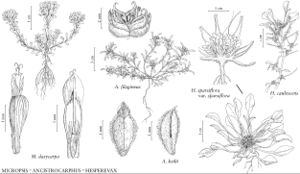Hesperevax
Proc. Amer. Acad. Arts 7: 356. 1868.
| Taxon | Illustrator ⠉ | |
|---|---|---|
 | Micropsis dasycarpa Ancistrocarphus filagineus Ancistrocarphus keilii Hesperevax sparsiflora var. sparsiflora Hesperevax caulescens | Linny Heagy Linny Heagy Linny Heagy |
Annuals, 0.5–10 (–20) cm. Stems 0, or 1, ± erect, or 2–10, ascending-erect to prostrate. Leaves basal or cauline; alternate (leaf or petiole bases yellowish, enlarged); blades oblanceolate to ± round. Heads usually in loose to dense glomerules of 2–40+ in cymiform or spiciform arrays, sometimes borne singly. Involucres 0. Phyllaries 0 or vestigial. Receptacles proximally conic, distally cylindric or slightly expanded (heights 0.8–1.3 or 4–6 times diams.), bristly (bristle lengths ± 1/2 palea lengths). Pistillate paleae persistent, erect to ascending or spreading; bodies with 5+ nerves (nerves ± parallel, obscure), obovate to oblanceolate, not gibbous, flat to concave or loosely folded most of lengths (almost closed near bases, not enclosing florets); wings 0. Staminate paleae persistent, usually 5, erect or distally spreading (and enlarged, thickened) in fruit, shorter than or surpassing pistillate paleae; bodies obovate (apices entire, blunt, adaxially green and lanuginose). Pistillate florets 3–25. Functionally staminate florets 2–6 (–12); corolla (zygomorphic, ± gibbous) lobes (3–) 4 (–5), unequal. Bisexual florets 0. Cypselae brown, proximally black-banded, monomorphic: obcompressed, obovoid (somewhat angular), slightly incurved, not gibbous, faces glabrous, smooth, dull to ± shiny; corolla scars apical; pappi 0.
Distribution
sw United States
Discussion
Species 3 (3 in the flora).
See discussion of Filagininae following tribal description (p. 385).
Hesperevax is known from sites in Mediterranean climates of western California and southwestern Oregon. Most of its taxa grow in distinctive habitats, where they tolerate or exploit moderate levels of disturbance.
Hesperevax is monophyletic and probably sister to Ancistrocarphus; Gifolaria (Cosson & Kralik) Pomel may also be related (J. D. Morefield 1992). Hesperevax is sharply distinct from Evax and relatives by receptacles bristly (unique in Filagininae), staminate paleae enlarged, thickened, apices erect or spreading, blunt, adaxially green and lanuginose, and staminate corollas zygomorphic (Morefield 1992c). The species are relatively easy to distinguish by the sizes, shapes, and arrangements of leaves, glomerules, and heads.
Selected References
Key
| 1 | Terminal heads in loose glomerules of 3–5, cylindric, heights 1.8–2.5 times diams.; capitular leaves 1–4 per glomerule or head; staminate paleae: apices ± erect | Hesperevax sparsiflora |
| 1 | Terminal heads borne singly or in dense glomerules of (2–)10–40+, campanulate or ± obpyramidal, heights 1–1.5 times diams.; capitular leaves 6–20 per glomerule or head; staminate paleae: apices spreading | > 2 |
| 2 | Largest leaves 4–22(–32) × 0.5–4(–5) mm; petiole lengths 0–1.5 times blade lengths, bases scarcely thickened, pliant to ± cartilaginous; heads borne singly or, rarely, in glomerules (3–7 mm diam.) of 2–8 mixed with leaves | Hesperevax acaulis |
| 2 | Largest leaves (25–)33–90 × 7–20 mm; petiole lengths 2–3 times blade lengths, bases thickened, indurate; heads in glomerules (10–25 mm diam.) of 10–40+ not mixed with leaves | Hesperevax caulescens |